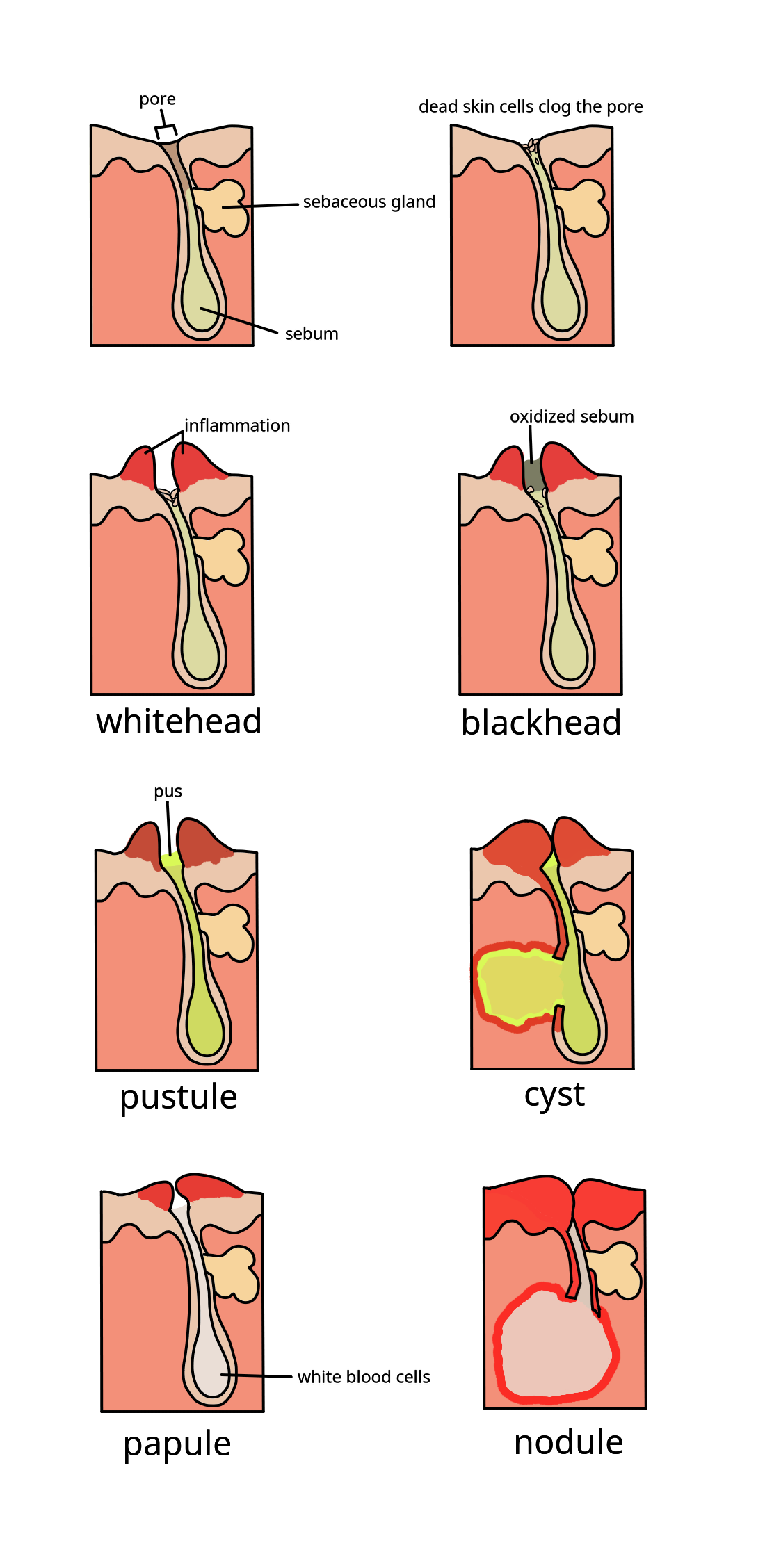|
Retinoid
The retinoids are a class of chemical compounds that are natural derivatives of vitamin A or are chemically related to it. Synthetic retinoids are utilized in cosmetic formulations, clinical dermatology, and the treatment of some forms of cancer. Retinoids have many important functions throughout the body, including in vision, regulation of skin proliferation and differentiation, growth of bone tissue, immune function, and male fertility. The biology of retinoids is complex, having well-documented effectiveness in the management of conditions ranging from acute promyelocytic leukemia to acne to photoaging. On the other hand, retinoids may be involved in metabolic dysfunction and, at least in some forms, carcinogenesis. Types Retinoids are divided into four generations based on their molecular structure and receptor selectivity. Structure The basic structure of the hydrophobic retinoid molecule consists of a cyclic end group, a polyene side chain and a polar end group. Th ... [...More Info...] [...Related Items...] OR: [Wikipedia] [Google] [Baidu] |
Acne
Acne ( ), also known as ''acne vulgaris'', is a long-term Cutaneous condition, skin condition that occurs when Keratinocyte, dead skin cells and Sebum, oil from the skin clog hair follicles. Typical features of the condition include comedo, blackheads or whiteheads, pimples, oily skin, and possible scarring. It primarily affects skin with a relatively high number of sebaceous gland, oil glands, including the face, upper part of the chest, and back. The resulting appearance can lead to lack of confidence, anxiety (mood), anxiety, reduced self-esteem, and, in extreme cases, clinical depression, depression or suicidal ideations, thoughts of suicide. Susceptibility to acne is primarily genetic in 80% of cases. The roles of diet and cigarette smoking in the condition are unclear, and neither hygiene, cleanliness nor exposure to sunlight are associated with acne. In both sexes, hormones called androgens appear to be part of the underlying mechanism, by causing increased production ... [...More Info...] [...Related Items...] OR: [Wikipedia] [Google] [Baidu] |
13-cis Retinoic Acid
Isotretinoin, also known as 13-''cis''-retinoic acid and sold under the brand name Accutane among others, is a medication used to treat skin diseases like harlequin-type ichthyosis, and lamellar ichthyosis, and severe cystic acne or moderate acne that is unresponsive to antibiotics. Isotretinoin is used off-label to treat basal cell carcinoma and squamous cell carcinoma, although clinical evidence suggests it is not effective in this setting. It is a retinoid, meaning it is related to vitamin A, and is found in small quantities naturally in the body. Its isomer, tretinoin, is also an acne drug. The most common adverse effects are dry lips ( cheilitis), dry and fragile skin (xeroderma), dry eyes and an increased susceptibility to sunburn. Uncommon and rare side effects include muscle aches and pains (myalgias), and headaches. Some of those side effects can persist long after the discontinuation of the use of the drug. Isotretinoin may cause liver failure, therefore the pat ... [...More Info...] [...Related Items...] OR: [Wikipedia] [Google] [Baidu] |
Tretinoin
Tretinoin, also known as all-''trans'' retinoic acid (ATRA), is a medication used for the treatment of acne and acute promyelocytic leukemia. For acne, it is applied to the skin as a cream, gel or ointment. For acute promyelocytic leukemia, it is effective only when the RARA-PML fusion mutation is present and is taken by mouth for up to three months. Topical tretinoin is also the most extensively investigated retinoid therapy for photoaging. Common side effects when used as a cream are limited to the skin and include skin redness, peeling, and sun sensitivity. When taken by mouth, side effects include hypertriglyceridemia, hypercholesterolemia, shortness of breath, headache, numbness, depression, skin dryness, itchiness, hair loss, vomiting, muscle pains, and vision changes. Other severe side effects include high white blood cell counts and blood clots. Use during pregnancy is contraindicated due to the risk of birth defects. It is in the retinoid family of medications ... [...More Info...] [...Related Items...] OR: [Wikipedia] [Google] [Baidu] |
Adapalene
Adapalene, sold under the brand name Differin among others, is a third-generation topical retinoid primarily used in the treatment of mild-moderate acne, and is also used off-label to treat keratosis pilaris as well as other skin conditions. Studies have found adapalene is as effective as other retinoids, while causing less irritation. It also has several advantages over other retinoids. The adapalene molecule is more stable compared to tretinoin and tazarotene, which leads to less concern for photodegradation. It is also chemically more stable compared to the other two retinoids, allowing it to be used in combination with benzoyl peroxide. Due to its effects on keratinocyte proliferation and differentiation, adapalene is superior to tretinoin for the treatment of comedonal acne and is often used as a first-line agent. The Swiss company Galderma developed adapalene. Medical uses Per the recommendations of the Global Alliance on Improving Outcomes of Acne, retinoids such as a ... [...More Info...] [...Related Items...] OR: [Wikipedia] [Google] [Baidu] |
Retinoid X Receptor
The retinoid X receptor (RXR) is a type of nuclear receptor that is activated by 9-cis retinoic acid, which is discussed controversially to be of endogenous relevance, and 9-''cis''-13,14-dihydroretinoic acid, which may be an endogenous mammalian RXR-selective agonist. Bexarotene is the only specific activator of the RXRs which does not activate the Retinoic Acid Receptors. There are three retinoic X receptors (RXR): RXR-alpha, RXR-beta, and RXR-gamma, encoded by the , , genes, respectively. RXR heterodimerizes with multiple nuclear receptors including CAR, FXR, LXR, PPAR, PXR, RAR, TR, ER and VDR. RXRs are permissive co-receptors as only one of six alleles is needed for normal development and health. Given this, it is difficult to extrapolate whether the RXR pathway has its own endogenous activity driven by 9-cis retinoic acid species or whether it merely participates in other pathways, predominantly the retinoic nuclear receptor pathway. Genomic knockout of th ... [...More Info...] [...Related Items...] OR: [Wikipedia] [Google] [Baidu] |
Tazarotene
Tazarotene, sold under the brand name Tazorac, among others, is a third-generation prescription topical retinoid. It is primarily used for the treatment of plaque psoriasis and acne. Tazarotene is also used as a therapeutic for photoaged and photodamaged skin. It is a member of the acetylenic class of retinoids. Tazarotene was approved for medical use in 1997 and is available as a generic medication. Medical uses Tazarotene is most commonly used topically to treat acne vulgaris and psoriasis. Like other topical retinoids, such as tretinoin and adapalene, tazarotene can be combined with benzoyl peroxide or an oral antibiotic, such as clindamycin or dapsone, for the treatment of acne. This results in increased efficacy compared to tazarotene monotherapy. For psoriasis, a combination therapy of tazarotene and a mid- to high-potency corticosteroid is more effective than either treatment alone. Tazarotene can also be used for the treatment of photodamaged skin. It can reduce ... [...More Info...] [...Related Items...] OR: [Wikipedia] [Google] [Baidu] |
Vitamin A
Vitamin A is a fat-soluble vitamin that is an essential nutrient. The term "vitamin A" encompasses a group of chemically related organic compounds that includes retinol, retinyl esters, and several provitamin (precursor) carotenoids, most notably Β-Carotene, β-carotene (''beta''-carotene). Vitamin A has multiple functions: growth during embryo development, maintaining the immune system, and healthy vision. For aiding vision specifically, it combines with the protein opsin to form rhodopsin, the light-absorbing molecule necessary for both low-light (scotopic vision) and color vision. Vitamin A occurs as two principal forms in foods: A) retinoids, found in Animal source foods, animal-sourced foods, either as retinol or bound to a fatty acid to become a retinyl ester, and B) the carotenoids Α-Carotene, α-carotene (''alpha''-carotene), β-carotene, Γ-Carotene, γ-carotene (''gamma''-carotene), and the xanthophyll beta-cryptoxanthin (all of which contain β-ionone rings) that ... [...More Info...] [...Related Items...] OR: [Wikipedia] [Google] [Baidu] |
Retinol
Retinol, also called vitamin A1, is a fat-soluble vitamin in the vitamin A family that is found in food and used as a dietary supplement. Retinol or other forms of vitamin A are needed for vision, cellular development, maintenance of skin and mucous membranes, immune function and reproductive development. Dietary sources include fish, dairy products, and meat. As a supplement it is used to treat and prevent vitamin A deficiency, especially that which results in xerophthalmia. It is taken by mouth or by intramuscular injection, injection into a muscle. As an ingredient in skin-care products, it is used to reduce wrinkles and other effects of skin aging. Retinol at normal doses is well tolerated. High doses may cause hepatomegaly, enlargement of the liver, dry skin, and hypervitaminosis A. High doses during pregnancy may harm the fetus. The body converts retinol to retinal and retinoic acid, through which it acts. Retinol was discovered in 1909, isolated in 1931, and first m ... [...More Info...] [...Related Items...] OR: [Wikipedia] [Google] [Baidu] |
Retinoic Acid Receptor
The retinoic acid receptor (RAR) is a type of nuclear receptor which can also act as a ligand-activated transcription factor that is activated by both all-trans retinoic acid and 9-cis retinoic acid, retinoid active derivatives of Vitamin A. They are typically found within the nucleus. There are three retinoic acid receptors (RAR), RAR-alpha, RAR-beta, and RAR-gamma, encoded by the , , genes, respectively. Within each RAR subtype there are various isoforms differing in their N-terminal region A. Multiple splice variants have been identified in human RARs: four for , five for , and two for . As with other type II nuclear receptors, RAR heterodimerizes with RXR and in the absence of ligand, the RAR/RXR dimer binds to hormone response elements known as retinoic acid response elements (RAREs) complexed with corepressor protein. Binding of agonist ligands to RAR results in dissociation of corepressor and recruitment of coactivator protein that, in turn, promotes transcript ... [...More Info...] [...Related Items...] OR: [Wikipedia] [Google] [Baidu] |


